Getting ready to strap on your lycra to ride some of the world's most amazing cycling trails? Here's everything you need to know about bike training and riding gear to best prepare you for your cycling tour – with added insider tips from our bike tour experts.
After months of dreaming and weeks of researching your ultimate cycling tour, you’ve booked your trip. Now all you have to do is sit back and wait for the day when you can finally head off on your long-awaited adventure… if only life could be that simple!
As with most things in life, you get out what you put in. So, you’ll need to do some physical conditioning to prepare. It’s also important to consider the appropriate clothing and gear to take on your trip. Adequate preparation will make your riding experience even more enjoyable.
To help you prepare, we’ve consulted our in-house cycling experts and bike addicts to compile the best tips and tricks on training and gear essentials you'll need to ensure you are comfortable and confident on your biking adventure.
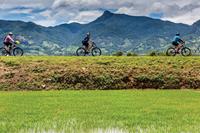
11 helpful training tips
1. Consider your trip grading
It's very important to be mindful of your trip grading and read your trip notes well in advance so that you know what type of cycling you'll face on your trip. There are a number of factors to consider preparing for which will help make your tour more enjoyable. Do you have one big day of hill climbing? Will the weather be quite hot at the time of year you are travelling?
Understanding your trip itinerary and grade will help shape your training sessions and give you guidelines on how much training you should do leading up to your trip.
If you are new to cycling and are feeling unsure, don’t be put off! It’s normal to feel a little nervous. Just remember, it’s not a race. Go at a pace you are comfortable with so you can soak up your surroundings along the way.
Furthermore, many of our tours have vehicle support, so if you aren't feeling up to riding one day there is always the option to have a rest. There's also the option to choose an e-bike for that extra pedalling boost.
2. Get miles on your legs
It may sound obvious, but the key to getting 'cycling fit' is spending as much time on your bike as possible. Don't make the mistake of thinking that running or swimming will suffice.
While it is good to mix up your workouts with cardio and weight bearing exercises, it is essential that you fit some riding time in your weekly workouts. Cycling regularly will activate different muscle groups, as well as get you used to sitting in your seat (or 'saddle') for long periods.
- Garry Corbett (journalist and avid cyclist)
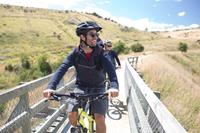
I jog a few times a week and this was the preparation I thought was enough for my cycle trip. But once on the bike, and facing 700-metre road ascents, I realised there is a big difference between running fit and cycling fit. Now, I always recommend people actually cycle in preparation for their cycle trip – a few times a week and not just on the bike in the gym (although, that is better than not cycling at all).
- Kate Baker (UTracks Manager)
3. Train consistently
Try to keep up a consistent amount of exercise each week, especially during the weeks leading up to your trip. Consistency and repetition are important for getting cycling fit.
To keep up consistent workouts, it’s a good idea to schedule them at the same time every week and fit them into your daily schedule. Also, remove as many barriers as possible, so you can’t come up with excuses not to train. For example, organise your gym clothes the night before, set reminders on your phone and keep a workout calendar.
4. Practice climbing hills
Let’s face it, not many people love riding up hills but the more you ride up them, the more you'll be prepared for them on your trip.
Basically the trick is to choose the “right” gear that allows you to pedal at your optimum speed. Choose a gear that is too low and you will spin the pedals too fast with the result that you will tire quickly or conversely choose a gear that is too high and you will have to expend too much energy with each turn of the pedals, with the result that you will tire quickly or potentially cause injury to your knees or hips.
- Garry Corbett
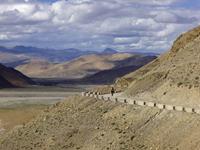
5. Be flexible
We all lead busy lives and it can be hard to fit specific training sessions into your everyday life. To fit in more time on your bike, try adding cycling to your daily routine, for example riding to the shops or work. This can also help build consistency.
The main thing I did to train was to get out on my bike as much as possible. I’d try and incorporate cycling into my every day life. Do I need to take the car to the shops? Maybe I could just pop to the shops on my bike if I only needed a couple of things. Making sure I had time in the ‘saddle’ (to prep butt and legs) was a key part of my preparation. Seeking out a few hills and stairs also helped me increase my leg strength.
- Kate Harper
6. Push yourself
The more you prepare, the more you’ll enjoy yourself. If you are only ‘just’ fit enough you won’t get as much out of your trip.
To put it bluntly if you want to get the most out of your long-awaited cycle tour you will need to do some sort of physical conditioning. This fact applies whether you have booked a so-called “easy” tour with few or no hills or if you have booked a tour that tackles some of the most arduous mountain climbs in the world.
- Garry Corbett
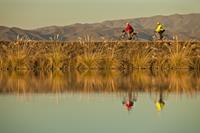
7. Train in a variety of weather conditions
Some of your training should reflect the trip conditions. If it might rain on your trip, then train in the rain and test your wet weather gear. See how rain impacts your riding style.
8. Get familiar with handling your bike
If you haven’t done lots of bike riding previously, make sure you are very comfortable with bike handling and functions. This includes changing gears, breaking and adjusting the bike.
On my first guided tour along the Loire Valley in France one lady in the group had never previously ridden a bicycle with gears. I chivalrously volunteered to spend the first half of the first day riding alongside her either changing the gears for her or supervising her own very ordinary attempts at what is, after all, a very basic task. The reality of the situation was that she should have been prepared for this basic task before she left home.
- Garry Corbett
9. Practice riding with other vehicles
If you’re going on a cycling trip in Southeast Asia for example, it’s important to practice cycling with other vehicles so you can build confidence near them.
Fitness is one thing, however, in Asia you are also dealing with other bikes, traffic, horns and people going about their daily lives. Building confidence riding with other cars, bikes, traffic etc, was also good preparation as it gives you an awareness of yourself on your bike in relation to other moving objects!
- Kate Harper
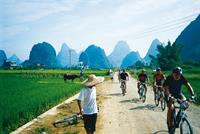
10. Ride on different surfaces
Your trip notes will give you an idea of the types of surfaces you will ride on during your trip. Will you be riding on dirt tracks, paved roads or rocky paths? Practice training on these surfaces so you are comfortable handling your bike in similar situations.
11. Mix up your workouts
If you are doing a multi-activity trip which might include cycling, kayaking or hiking, make sure you mix up your training sessions.
It was tricky training for the Bike, Hike and Kayak North Vietnam trip because of the three different elements. About three months before departure, I introduced swimming a couple of times a week to my regular walking routine because I thought it would help with the kayaking. Also, I sought out walks with rougher, steeper terrain to my regular routes. I made the mistake of thinking the extra walking would be my bike training, so it was lucky I got on the bike a month or so beforehand. My legs were jelly the first few rides but I improved fast due to my baseline fitness. In hindsight, I should have started on all three activities from the beginning.
– Michele Eckersley
6 essential bike gear tips
What clothing and equipment should you take on your cycling tour? It may seem like a mundane subject to think about, when all you want to do is hop on your bike and go. Yet, it is absolutely essential that you get the gear right!
The bottom line is that you have booked a cycling tour because you enjoy cycling. You want to soak up the culture of a new country at a relaxed pace from the comfortable saddle of your bike.
1. Ensure you have quality wet weather gear
Invest in good quality wet weather gear – including a rain jacket and pack cover. You won’t regret it!
On a social ride, which for all intents and purposes the vast majority of organised cycle tours are, there is nothing worse than riding in the rain without adequate protection – especially if it is cold rain!
- Garry Corbett
2. Replicate your comfortable set-up
Whilst it’s not a requirement on our cycling trips that you bring all your own gear if you already have a comfortable set-up at home, it’s a good idea replicate it on your trip. This could include your saddle, clip-ins for SPD’s and ergonomic handlebar grips. If you don’t have these, buy them is not essential. It’s just recommended to replicate your own set-up if you already have one.
Some of our trips may need you to bring your own helmet, and most seats can be adjusted to our bikes in country. You will be sent a pre-departure kit before you leave with all sorts of important information, including a comprehensive gear list. Our travel experts are also always on-hand to advise on recommended gear.
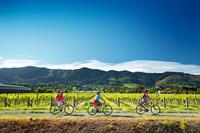
3. Consider wearing a bike jersey
Bike jerseys with a number of pockets on the back are another good addition to your wardrobe for both comfort and convenience. Don’t worry, not all of them look like a brightly coloured billboard.
The pockets can conveniently hold everything from snacks to cameras and money. It is important to note here that if you shop around you can purchase cycle jerseys that do not make you look like a Tour de France contender.
4. Cycling gloves make a big difference
Cycling gloves are another addition to your wardrobe that are highly recommended when cycle touring. While gloves may seem like a small consideration, they serve a number of very important functions including grip and sun protection.
First and foremost, gloves keep the hot sun off the back of your hands, but on a more practical level they stop blisters, chafing and other discomfort caused by the constant friction of handlebars and road vibration against the skin of your hands - especially when they are damp with sweat.
If you have booked a mountain bike tour, the extra grip provided by gloves could mean the difference between staying on your seat or taking a tumble and landing on the ground. The improved grip enables better control of your bike because your hands are less likely to slip on the handlebars each time you turn.
- Garry Corbett
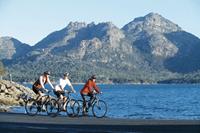
5. Comfort is key
While it’s important to focus on fitness, one shouldn’t forget about comfort. If you’re feeling uncomfortable it will make it hard to enjoy your trip.
All your contact points must be really comfortable including your hands, backside and feet. If you are not used to long periods of riding we recommend buying a gel seat pad or padded cycling pants.
Sitting on a bike seat for multiple hours can present some challenges if you haven’t done so for a long time, or at all. Some people like to bring padded bike pants, others gel seats, and while they all help to some degree nothing aids your buttocks better than getting it used to being on a bike seat gradually before your trip. Just like you wear your boots in to avoid blisters before a trip, wear your bum in by sitting on the bike before you travel.
- Brad Atwal
6. Wear synthetic clothing – not cotton
Carefully consider the clothing you pack before you leave and consider investing in some quick-drying clothes. Cotton does not dry quickly and can hold too much moisture.
It is best to bring along fast-drying clothing that is predominantly synthetic or of a synthetic blend. Cotton holds onto moisture and can be a cyclist’s worst enemy. Not only does it look unsightly to be wearing a T-shirt and shorts soaked with sweat, but the moisture magnifies both heat and cold and can make things very uncomfortable.
- Garry Corbett
Explore the world on two wheels with World Expeditions
Cycling adventures are the perfect means to explore destinations at a relaxed pace, allowing you the time to delve into the local culture and discover hidden gems which are off the beaten path. You don’t have to be a cycling novice to explore the world on two – we operate a range of cycling holidays to suit all levels of cycling ability from beginners to more advanced. Browse all cycling adventures >